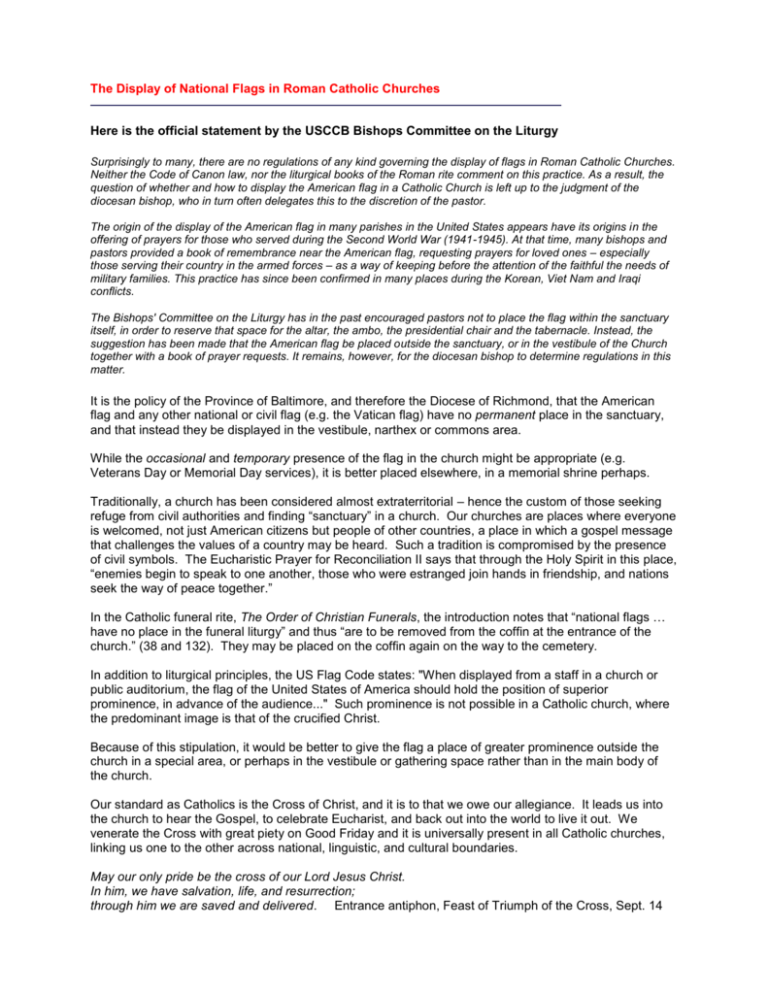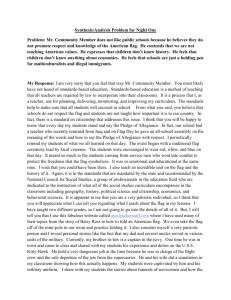The Display of National Flags in Roman Catholic Churches
advertisement

The Display of National Flags in Roman Catholic Churches Here is the official statement by the USCCB Bishops Committee on the Liturgy Surprisingly to many, there are no regulations of any kind governing the display of flags in Roman Catholic Churches. Neither the Code of Canon law, nor the liturgical books of the Roman rite comment on this practice. As a result, the question of whether and how to display the American flag in a Catholic Church is left up to the judgment of the diocesan bishop, who in turn often delegates this to the discretion of the pastor. The origin of the display of the American flag in many parishes in the United States appears have its origins in the offering of prayers for those who served during the Second World War (1941-1945). At that time, many bishops and pastors provided a book of remembrance near the American flag, requesting prayers for loved ones – especially those serving their country in the armed forces – as a way of keeping before the attention of the faithful the needs of military families. This practice has since been confirmed in many places during the Korean, Viet Nam and Iraqi conflicts. The Bishops' Committee on the Liturgy has in the past encouraged pastors not to place the flag within the sanctuary itself, in order to reserve that space for the altar, the ambo, the presidential chair and the tabernacle. Instead, the suggestion has been made that the American flag be placed outside the sanctuary, or in the vestibule of the Church together with a book of prayer requests. It remains, however, for the diocesan bishop to determine regulations in this matter. It is the policy of the Province of Baltimore, and therefore the Diocese of Richmond, that the American flag and any other national or civil flag (e.g. the Vatican flag) have no permanent place in the sanctuary, and that instead they be displayed in the vestibule, narthex or commons area. While the occasional and temporary presence of the flag in the church might be appropriate (e.g. Veterans Day or Memorial Day services), it is better placed elsewhere, in a memorial shrine perhaps. Traditionally, a church has been considered almost extraterritorial – hence the custom of those seeking refuge from civil authorities and finding “sanctuary” in a church. Our churches are places where everyone is welcomed, not just American citizens but people of other countries, a place in which a gospel message that challenges the values of a country may be heard. Such a tradition is compromised by the presence of civil symbols. The Eucharistic Prayer for Reconciliation II says that through the Holy Spirit in this place, “enemies begin to speak to one another, those who were estranged join hands in friendship, and nations seek the way of peace together.” In the Catholic funeral rite, The Order of Christian Funerals, the introduction notes that “national flags … have no place in the funeral liturgy” and thus “are to be removed from the coffin at the entrance of the church.” (38 and 132). They may be placed on the coffin again on the way to the cemetery. In addition to liturgical principles, the US Flag Code states: "When displayed from a staff in a church or public auditorium, the flag of the United States of America should hold the position of superior prominence, in advance of the audience..." Such prominence is not possible in a Catholic church, where the predominant image is that of the crucified Christ. Because of this stipulation, it would be better to give the flag a place of greater prominence outside the church in a special area, or perhaps in the vestibule or gathering space rather than in the main body of the church. Our standard as Catholics is the Cross of Christ, and it is to that we owe our allegiance. It leads us into the church to hear the Gospel, to celebrate Eucharist, and back out into the world to live it out. We venerate the Cross with great piety on Good Friday and it is universally present in all Catholic churches, linking us one to the other across national, linguistic, and cultural boundaries. May our only pride be the cross of our Lord Jesus Christ. In him, we have salvation, life, and resurrection; through him we are saved and delivered. Entrance antiphon, Feast of Triumph of the Cross, Sept. 14








